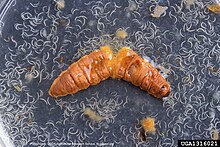Heterorhabditis megidis
| Heterorhabditis megidis | |
|---|---|

| |
| Entomopathogenic nematodes emerging from a wax moth cadaver | |
| Scientific classification | |
| Domain: | Eukaryota |
| Kingdom: | Animalia |
| Phylum: | Nematoda |
| Class: | Chromadorea |
| Order: | Rhabditida |
| Family: | Heterorhabditidae |
| Genus: | Heterorhabditis |
| Species: | H. megidis
|
| Binomial name | |
| Heterorhabditis megidis Poinar, Jackson & Klein, 1987
| |
Heterorhabditis megidis is a species of nematodes in the genus Heterorhabditis. All species of this genus are obligate parasites of insects, and some are used as biological control agents for the control of pest insects.
Heterorhabditis megidis nematodes are hosts for the Photorhabdus luminescens bacterial symbiont. It can be used to fight the Japanese beetle, Popillia japonica (Scarabaeidae: Coleoptera), in Ohio.[1]
3,5-Dihydroxy-4-isopropyl-trans-stilbene is a bacterial stilbenoid produced by the P. luminescens bacterial symbiont species of the entomopathogenic nematode, H. megidis. Experiments with infected larvae of Galleria mellonella, the wax moth, support the hypothesis that the compound has antibiotic properties that help minimize competition from other microorganisms and prevents the putrefaction of the nematode-infected insect cadaver.[2]
References
[edit]- ^ Poinar, G.O., Jr., T. Jackson and M. Klein (1987) "Heterorhabditis megidis sp. n. (Heterorhabditidae: Rhabditida) parasitic in the Japanese beetle, Popillia japonica (Scarabaeidae: Coleoptera), in Ohio." Proceedings of the Helminthological Society of Washington 54(1):53-59.
- ^ Hu, K; Webster, JM (2000). "Antibiotic production in relation to bacterial growth and nematode development in Photorhabdus--Heterorhabditis infected Galleria mellonella larvae". FEMS Microbiology Letters. 189 (2): 219–23. doi:10.1111/j.1574-6968.2000.tb09234.x. PMID 10930742.
External links
[edit]
